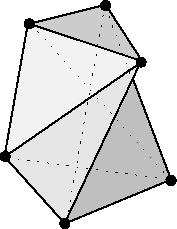A constrained Delaunay Triangulation (CDT) [155] is
depicted in Fig. 5.3-b. The boundary edges are preserved and not
split into smaller edges by avoiding the insertion of additional points.
Their presence in the CDT is ensured through local modifications
where Delaunay edges are removed or flipped.
The resulting Delaunay Triangulation is said to be constrained by the
boundary. Elements near the boundary are not guaranteed to satisfy
the Delaunay criterion.
Even though the smallest sphere criterion (Crit. 3.1) for
boundary edges is stronger than the Delaunay criterion, it can
paradoxically be of advantage for meshing applications to use
CDT. The reason lies in the for meshing applications different
perception of proximity as can be seen in Fig. 5.4. If one
defines as medium for visibility the mesh elements, the point ![]() in
Fig. 5.4 is invisible from the edge
in
Fig. 5.4 is invisible from the edge ![]() . Therefore, for the
mesh element adjacent at edge
. Therefore, for the
mesh element adjacent at edge ![]() the point
the point ![]() can be ignored and the
smallest sphere criterion is in this sense fulfilled, although the edge
can be ignored and the
smallest sphere criterion is in this sense fulfilled, although the edge ![]() is not even a Delaunay edge. If the boundary depicted in the figure were an
interface between the meshes of two regions, the point
is not even a Delaunay edge. If the boundary depicted in the figure were an
interface between the meshes of two regions, the point ![]() would certainly
inflict the smallest sphere criterion of edge
would certainly
inflict the smallest sphere criterion of edge ![]() , and the Delaunay
criterion for the interface edges would not be sufficient but necessary.
, and the Delaunay
criterion for the interface edges would not be sufficient but necessary.
![\includegraphics [width=0.9\textwidth]{ppl/advcdt.ps}](img241.gif)
|
Contrary to the two-dimensional case a constrained Delaunay Triangulation does not exist a priori in three dimensions. Constellations of boundary facets exist which cannot be tetrahedralized without the insertion of additional points on the boundary. In other words no tetrahedralization can be found regardless of Delaunay criteria which allows the preservation of the boundary facets. An example of such a constellation is the twisted prism or Schönhardt polyhedron [149] which requires the insertion of at least one additional vertex (Fig. 5.5). No tetrahedron can be attached to the bottom facet with any of the top three vertices as fourth point without that it intersects one of the diagonal side edges.

|